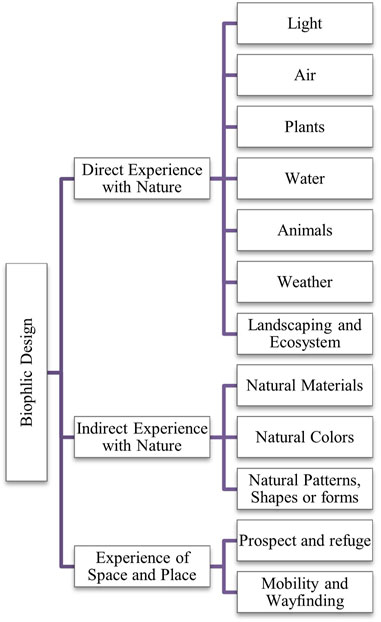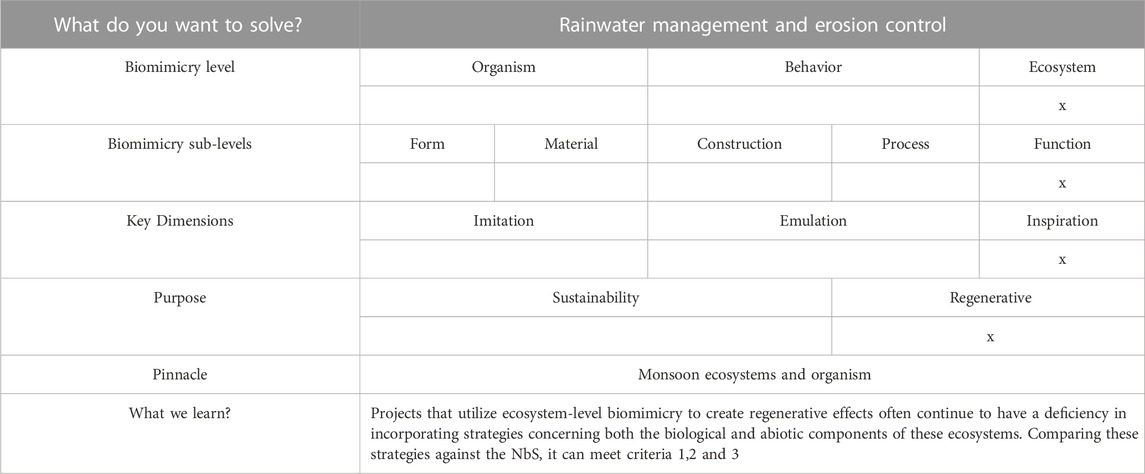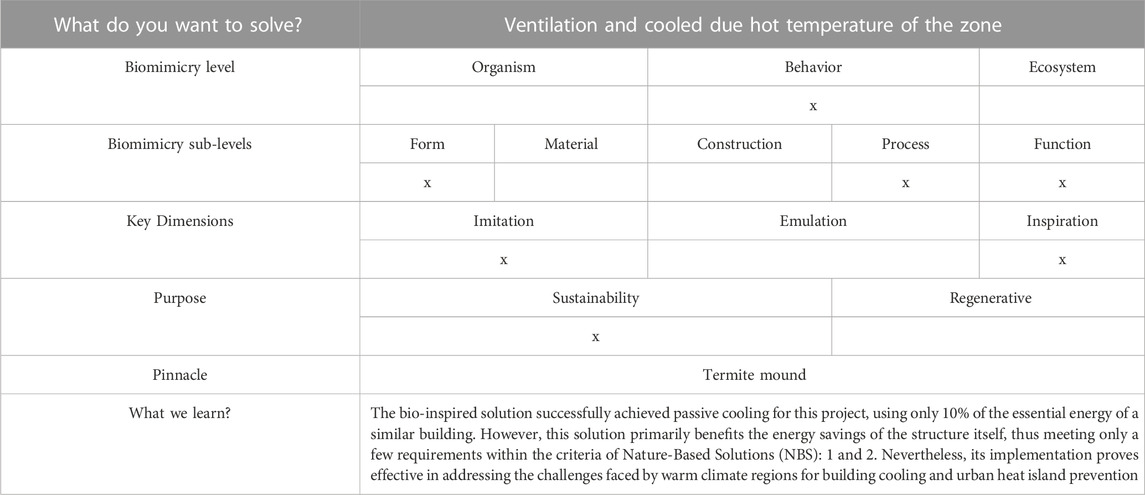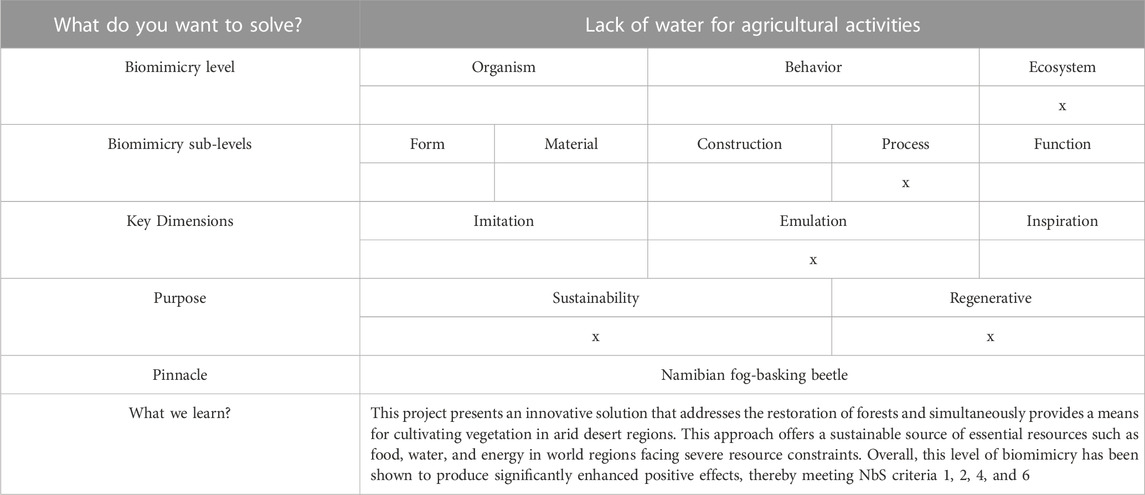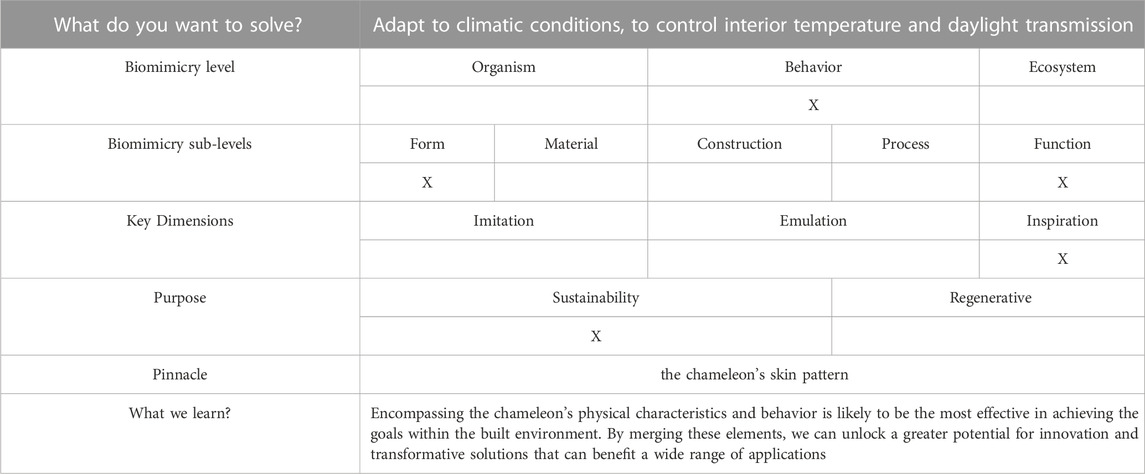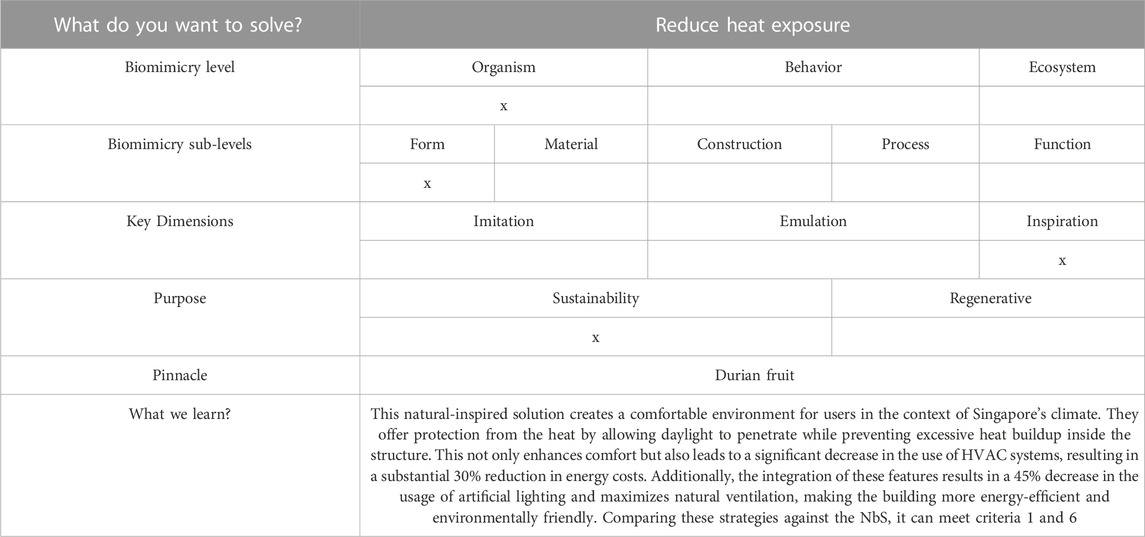- 1Research Group in Energy and Comfort in Bioclimatic Buildings (ECEB), Faculty of Mechanical Engineering, Universidad Tecnologica de Panama, Panama, Panama
- 2Centro de Estudios Multidisciplinarios en Ciencias, Ingeniería y Tecnología (CEMCIT-AIP), Panama, Panama
- 3Sistema Nacional de Investigación (SNI), Panama, Panama
The rapid increase in the population, which has been concentrated mainly in urban areas, has caused an environmental imbalance over the years since the built environment developed as a foreign element to the ecosystem, which prevents having resilient environments capable of adapting to the challenges posed by climate change. This research aims to provide an updated knowledge base of bio-inspired strategies emulated in hot and humid climates to achieve an efficient built environment, restoring resources, and bringing nature closer to cities. A systematic review is conducted based on keyword selection to answer i) what has been achieved in built environments to be more efficient and sustainable (including tropical climates) and ii) how natural patterns, strategies, and models are mimicked. Implementing these strategies is very little in regions with hot and humid climates. Bio-inspired approaches are concentrated in those that try to emulate the functions of nature, followed by approaches that imitate the form of nature, biomimicry, and biomimetics being the most used approaches, leading to the development of efficient and resilient cities.
1 Introduction
In recent years the world has experienced a rapid increase in population, absorbed mostly in urban areas, and according to the UN-Habitat report (Judith Oginga, 2022), it is estimated that by 2050 70% of the population will live in cities. As cities are the main habitat of human beings, they depend to a large extent on the resources of their environment, and their development over the years has caused an environmental imbalance because a large part of the buildings was built as elements foreign to the ecosystem (Othmani et al., 2022), which prevent having resilient environments incapable of adapting to the challenges caused by climate change, improving human wellbeing, biodiversity and resource recovery.
To repair environmental damage caused by urbanization processes, solutions that provide a balance for both nature and society begin to be implemented. Consequently, the concept of nature-based solutions (NbS) was mentioned for the first time in 2008 by the World Bank and officially established in 2015 by the European Commission (Sowińska-Świerkosz and García, 2022), which defines it as actions inspired, supported, or copied from nature, while the International Union for Conservation of Nature (IUCN) defines it as “actions to protect, sustainably manage and restore natural or modified resources” (Matthews et al., 2022). Recent research raises this concept of bringing nature to cities and emphasizes that its application is not limited to the restoration of biodiversity; its benefits extend to social and economic levels.
It is argued that nature-based solutions contain a series of objectives focused on mitigation and adaptation to climate change and that in the last 15 years, their application has been inserted in the design of buildings and urban spaces: what we know as the built environment (IUCN, 2020a), and these applications range from creating green areas to counteract the high temperatures caused by the urban heat island (UHI) effect, and using natural materials. However, there exists a debate in the literature on what types of interventions can be considered NbS.
That is why recent studies (Sowińska-Świerkosz and García, 2022) address this research gap to clarify doubts about the criteria that must be considered to identify those solutions based on nature and that effectively comply with those mentioned in the Global Standard of the International Union for Conservation of Nature (IUCN) (IUCN, 2020a), published in 2020, it consists of eight criteria (IUCN, 2020b) (Table 1).
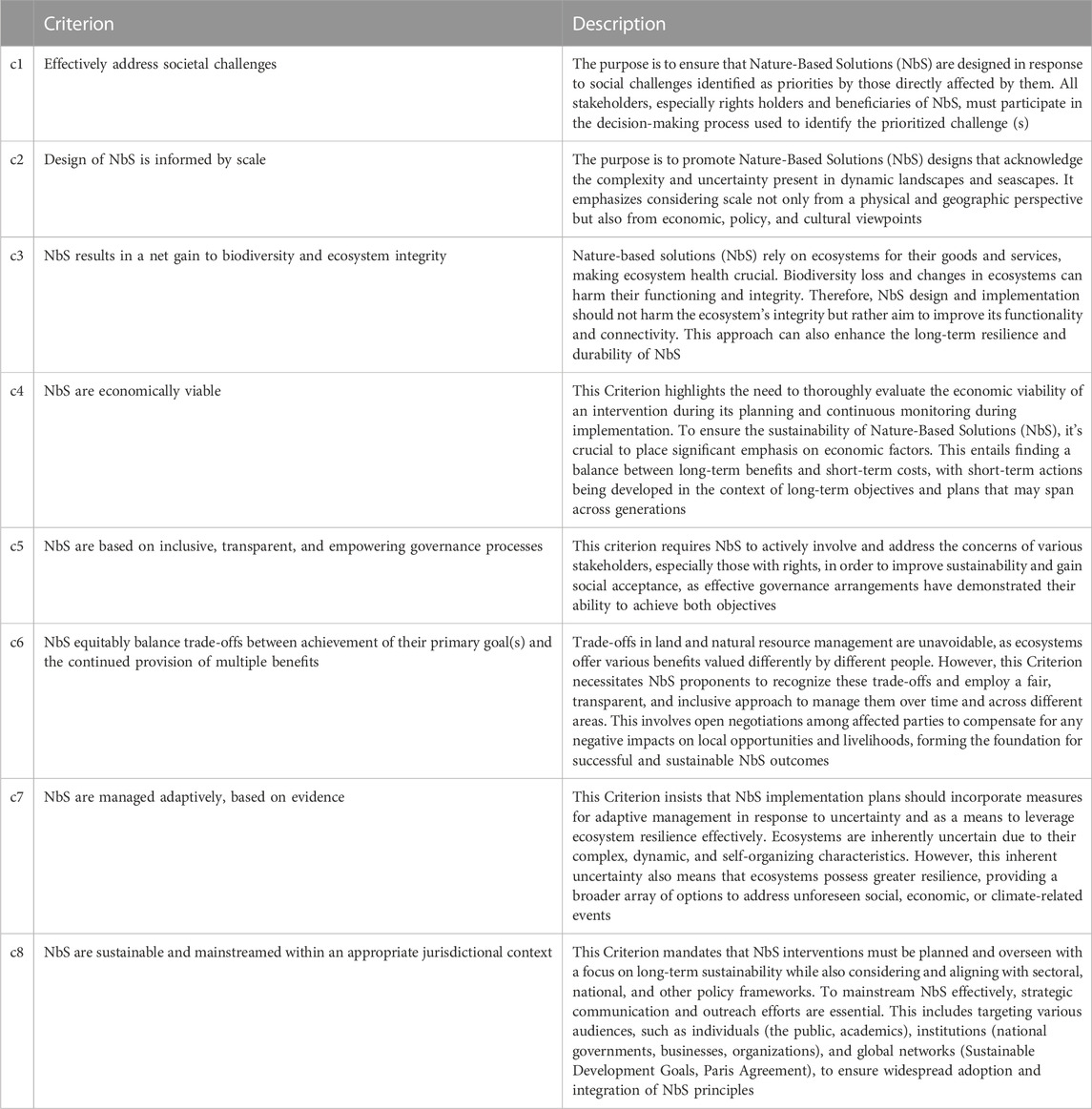
TABLE 1. Criteria considered to classified solutions as nature-based (IUCN, 2020b).
Consequently, the primary aim of NbS is to assist in reaching society’s development objectives while preserving human wellbeing in alignment with cultural and societal principles. NbS also seeks to boost the resilience of ecosystems, their ability to regenerate, and their capacity to provide essential services (IUCN, 2016). The eight process-oriented Criteria address the key design and future implementation considerations that an intervention must meet to be classified as an NbS. These Criteria align with a project management cycle, emphasizing the importance of looking beyond the project’s specific location and timeframe. They also underscore the necessity of practicing adaptive management because NbS design relies on a theory of change that inherently includes assumptions to be validated during implementation.
Otherwise, approaches inspired by nature have been present in many fields, including architecture and urban planning, with bionics, biomimetics, and biomimicry being the three bio-inspired design approaches commonly referred to. Bionics as a general terminology began to be implemented in 1958 by Jack Steel as a combination of biology and technique; it focuses on the mechanical abilities of nature, extracting its physical principles as inspiration for developing a technical design. However, the practice of it can lead to unsustainable solutions since it does not consider the interaction of these solutions with sustainability (Landrum and Mead, 2022). Meanwhile, through understanding and analysis, biomimetics transfers characteristics, qualities, and systems from nature to the artificial environment (Urdinola-Serna and diseño, 2018). The term biomimetic, which comes from the roots bios (life) and mimesis (imitate), dates to 1969, thanks to the biophysicist and engineer Otto Schmitt, and focuses mainly on imitating nature, both the application and in form. Finally, biomimicry was defined by Benyus in 1997 as the science that imitates the models of nature and that, in turn, uses an ecological standard that measures its interaction with the environment, which takes it one step beyond bionic and biomimetic, worrying about sustainability in its application (Landrum and Mead, 2022).
1.1 Approaches in biomimicry design
In the biomimicry design process, a bidirectional method is applied and consists of two approaches (Bader et al., 2021; Chayaamor-Heil, 2023; Urdinola-Serna and diseño, 2018):
• Problem-Oriented Approach: In this approach, designers first identify the goals and parameters of the problem they are addressing. Afterward, they search for solutions in the plant or animal kingdom that can be applied to that specific problem.
• Solution-Oriented Approach: This approach is carried out by individuals with scientific knowledge who seek potentially relevant applications for design. In other words, they focus on identifying principles, behaviors, or functions that are relevant in organisms or ecosystems and can be useful in solving a design problem.
1.2 Levels in biomimicry design
Biomimetic design can draw inspiration from nature at three distinct levels: organism, behavior, and ecosystem (Bader et al., 2021; Chayaamor-Heil, 2023):
• The organism level involves imitating specific plants or animals, which may encompass replicating either a part or the entirety of the organism.
• The behavior level entails mimicking the behavior of a living being, potentially translating an aspect of its actions and how they relate to a broader context.
• The ecosystem level focuses on emulating entire natural ecosystems and the underlying principles that enable them to function effectively.
According to the literature (Mirniazmandan and Rahimianzarif, 2017), 5 sub-levels are proposed for imitation, which are: form, material, construction, process, and function. Three key dimensions are also mentioned to abstract the idea of nature: imitation, emulation, and inspiration (Oguntona and Aigbavboa, 2023a).
Another approach that involves the relationship between nature and the morphology of the building is biophilia, which, although not considered within the framework of bio-inspired solutions, shares a paradigm shift in our relationship with nature (Chayaamor-Heil, 2023). Keller and Edward Wilson define biophilia as the human inclination to affiliate with nature, this behavior has been present during most of the history of our species as we develop biologically in the adaptive response to natural forces. As indicated by the book The Practice of Biophilic Design (Calabrese, 2015), it can be said that biophilic design seeks to address the deficiencies that exist in modern constructions that prevent establishing that connection with nature, that is, the biophilic design aims to create a good habitat for people as a biological organism in the modern built environment, and is governed by certain basic principles: Environmental features, natural shapes and forms, natural patterns and processes, light and space, place-based relationships and involved human-nature relationships.
Although Nature-based Solutions harness the capabilities of operational ecosystems as a form of infrastructure to offer natural services that promote the wellbeing of both society and the environment, it is important to note that nature-derived and nature-inspired solutions are distinct from them. Nature-inspired solutions are distinct from Nature-Based Solutions as they do not rely on operational ecosystems (IUCN, 2020b).
Bio-inspired solutions are part of the nature-inspired solutions (NiS) that encompass creative approaches to designing and producing materials, structures, and systems that draw inspiration from biological processes in nature, as seen in Figure 1. For instance, biomimicry involves studying and emulating strategies observed in the natural world to address various challenges (IUCN, 2020b).
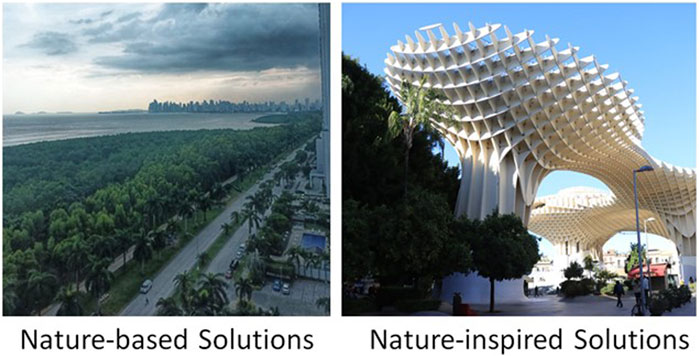
FIGURE 1. On the left, an example of NbS is shown, aimed at sustainably protecting, managing, and restoring the modified ecosystem at the landscape scale, effectively addressing both human wellbeing and nature conservation while meeting established criteria. On the right, is an example of a nature-inspired solution from biological aspects that solves specific problems in the built environment.
The difference between nature-inspired and bio-inspired is clearly highlighted in Figure 2. This scheme visually illustrates the hierarchy of concepts in the field of nature-inspired design. “Nature-Inspired” serves as the epicenter, dividing into two main branches: “Nature-Based” and “Bio-Inspired.” The first, “Nature-Based,” is portrayed as the fundamental root, connecting directly with the essence of nature. The “Bio-Inspired” branch delves into more specialized terrain, dividing into three key subcategories: “Bionics,” “Biomimetics,” and “Biomimicry.” Each of these subdivisions is represented as specific branches exploring the application of biological inspiration in different fields. Consequently, we have “Biologically-Inspired Design,” manifested in creativity and innovation in solutions influenced by biology.
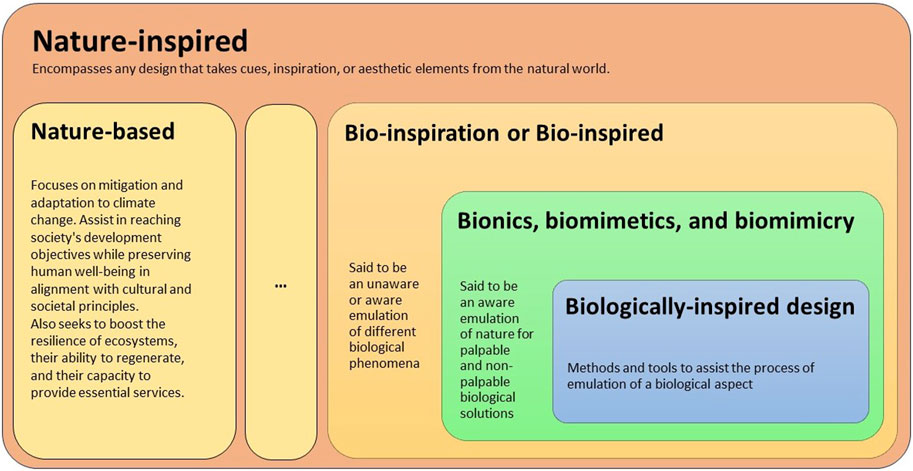
FIGURE 2. Complexity and interconnection among the terms “nature-inspired,” “nature-based,” and “bio-inspired” as per their epistemology, based on (Austin et al., 2023; Bianciardi et al., 2023; ISO, 18458, 2015).
Nature operates in a balanced manner to promote life and optimize the use of resources and energy. Consequently, bio-inspired models must carefully consider the quality and quantity of materials, as well as the processes involved in the design and production of objects and technologies (Urdinola-Serna and diseño, 2018). As indicated in the literature, the rationale behind sustainability in the construction industry is to focus on ecological conditions to achieve a built environment with the best attributes that reduce the adverse impacts of the sector (Austin et al., 2023) and suppose the construction industry has been largely responsible for the disconnection that exists with nature. In that case, identifying those bio-inspired strategies that create resilient environments is of great help (Pearlmutter et al., 2020).
This document seeks to investigate the influence of bio-inspired solutions on the built environment, assess the extent of their impact, and analyze the strategies applied in regions characterized by hot and humid climates. To address this research inquiry, a comprehensive review is conducted to delineate the challenges encountered by urban areas. Subsequently, the various bio-inspired strategies are elaborated upon, culminating in the analysis of case studies specific to hot and humid climatic conditions.
By addressing the question of the influence of existing inspired solutions on the built environment, this project provides a current overview of their application in regions of hot and humid climates. This improved understanding helps identify strategies that can be implemented in cities with similar characteristics and problems to achieve environmental balance, adaptation to the challenges of climate change, and resource recovery. To the best knowledge of the authors, the novelty of this review is highlighted in the discussion section where only real case studies are analyzed based on purpose, NbS criteria, and NiS.
2 Methodology
The methodology employed focuses on finding relevant scientific documents related to the main topic via keyword combination by following the flow path presented in Figure 3. The databases explored were Google Scholar and ScienceDirect. Given the objective of the present review study, the keywords used respond to: i) what has been achieved regarding built environments to be more efficient and sustainable, using nature-based inspiration, under hot and humid climates, including tropical climates. and ii) how natural patterns, natural strategies, and functions are mimicked.
1. Only open-access documents.
2. Only studies that follow a scientific method, excluding gray literature from the case studies.
3. Only studies that achieve the implementation phase, especially real cases of success.
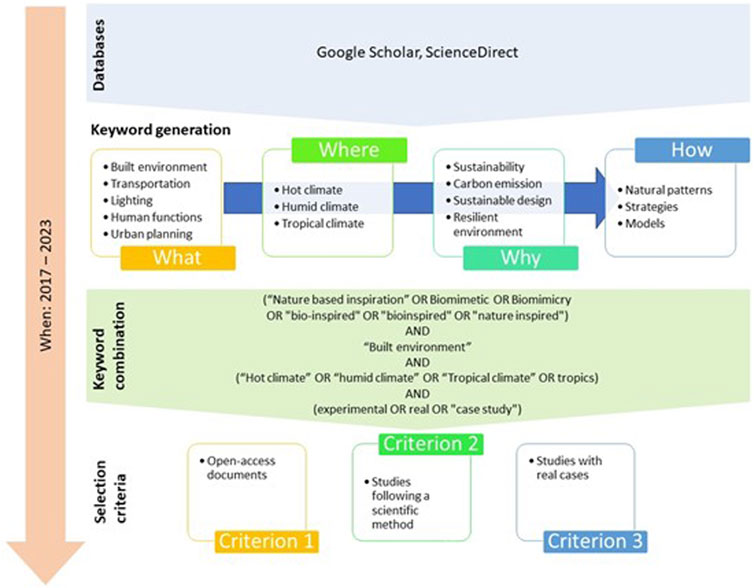
FIGURE 3. Flow path employed for keyword combination strategy for documentation searching. The keywords chosen were combined into the following: (“Nature based inspiration” OR Biomimetic OR Biomimicry OR “bioinspired” OR “bio-inspired” OR “nature inspired”) AND “Built environment” AND (“Hot climate” OR “humid climate” OR “Tropical climate” OR tropics) AND (experimental OR real OR “case study”). This keyword combination was accompanied by the following criteria to choose among the documents found.
This search strategy yielded 169 documents with few studies regarding tropical climate, however, only a list of 52 documents were used where only six real case studies were found. Figure 3 shows the overlay representation of the keywords found in all documents based on their co-occurrence. The color code represents the year of publication of the document. Among these documents, the keyword “biomimicry” (light green) appeared 12 times, followed by “sustainability” (green) with 11 occurrences, and “thermal comfort” (blue) and “energy efficiency” (purple) with the same occurrence of six.
By analyzing Figure 4, the “built environment” has been a subject of interest for past years as well as “energy efficiency” in buildings. However, documents in 2020 shifted from including such terms as keywords to using “urban ecosystems,” “green infrastructure,” “climate change adaptation,” and “circular economy.” With this, the sustainability concept appeared to be the focus of research in buildings. In the transition of 2020-2021, inspiration in nature has been studied for applications under tropical climates, such as in (Austin et al., 2020), where documents used keywords such as “biophilia” and “nature-based solutions.” In 2021-2022, the terms “biomimicry” and “bio-inspired design” were included as keywords showing researchers focused on nature relations with architecture and building design for achieving sustainability, particularly in such a climate, such as in (Solano et al., 2022).
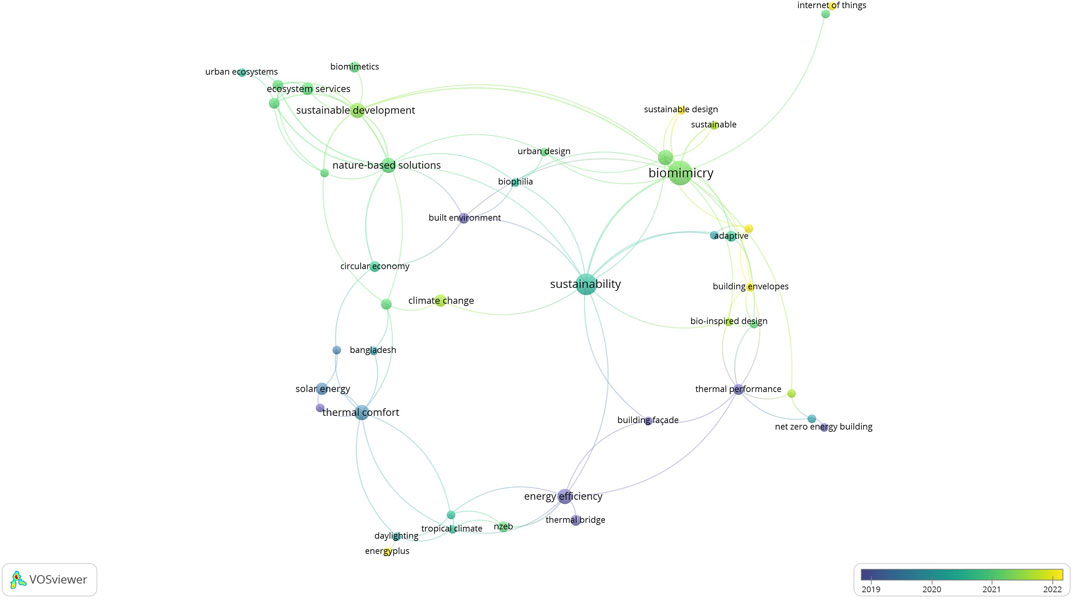
FIGURE 4. Overlay visualization map of research trends over past few years based on keyword co-occurrence. Keyword occurrence threshold is two with full counting method.
Figure 4 also shows that currently, nature continues to be a source of inspiration for building designs, particularly at the envelope level with adaptive characteristics (e.g., materials), with the purpose of sustainable development in the built environment for tropical climate.
This document is structured as follows: problems and challenges faced by cities, nature as a model in the built environment design, and we will analyze real case studies that have been developed in hot and humid environments. For that, we will summarize the key principles of biomimicry life, which help classify bio-inspired solutions. Furthermore, we will assess these solutions to determine if they also align with the criteria for nature-based solutions (NbS).
3 Problems and challenges of cities
Huge swaths of land have been destroyed and replaced by man-made systems, be it agricultural, industrial, or urban activities operating differently from nature (Dicks, 2023). The conservation of the natural environment has always been seen for most of the twentieth century as an obstacle to development, and not recognizing that nature is a fundamental part of human existence leads us to scenarios where the loss of biodiversity prevents us from using the resources it offers us to solve the social challenges attributed to climate change, food security, and disaster risk reduction (IUCN, 2020a). Cities were not prepared or planned to face global challenges, as mentioned in the World Cities Report 2022 (Judith Oginga, 2022), listing a series of key ideas where the emergence of urbanization as a megatrend intertwined with existential challenges is highlighted, where resilience building is critical for urban areas to be prepared for dynamic and unpredictable futures.
Moreover, research related to NBS in the built urban environment (Pearlmutter et al., 2020) identifies the main challenges facing urbanization and growth of cities, highlighting the high energy consumption of buildings for their operation and which is directly related to greenhouse gas (GHG) emissions, the production of construction materials, the reduction of green spaces by built surfaces, either by buildings or by the extensive areas covered by non-permeable pavements, which interrupt the natural cycle of ecosystems, creating stressful microclimatic conditions due to the increase in temperatures and that lead society to depend on refrigerated indoor spaces and avoid outdoor pedestrian activities.
Cities located in humid and warm regions present even greater challenges due to their geographical conditions, coupled with the fact that most human settlements were developed in areas vulnerable to the dangers caused by climate change, such as rising sea levels, coastal storms, extreme heat, floods, and droughts, which at the same time cause negative social, ecological, and technical impacts (Hobbie and Grimm, 2020).
Therefore, it is vital to achieve sustainable development within urban areas that focus on solving those most frequent challenges and needs, implementing actions that are respectful of the environment, and promoting the efficient use of resources with a view to a clean and circular economy.
4 Nature as model in the built environment design
Nature has always been a source of inspiration for architecture, creating various bio-movements through the historical period, from Gaudí’s biomorphic architecture to Santiago Calatrava’s contemporary architecture; both are influenced by forms found in nature. However, there is a trend for an interdisciplinary design that seeks not only inspiration in free aesthetic forms but also those biological inspirations that minimize the use of natural resources and the carbon footprint, which makes it sustainable architecture that responds to the change of an industrial era to the ecological era of humanity (Dixit and Stefańska, 2023). The adaptability of nature to different environmental changes has been well reported in the literature (Jamei and Vrcelj, 2021), and as mentioned in (Wu et al., 2020), one of the main purposes of using bio-inspired designs or designing with nature is to restore the patterns of the environment, and landscape that, in turn, converts the built environment into efficient cities with low carbon production and resilient. Such is the case of China, which has implemented sustainable ecological development in cities in the last 50 years; they are ecological cities that restore the ecosystem and integrate into it, focusing on five elements: energy, food, transport, waste, and water.
Bio-inspired concepts in the design of the built environment have manifested themselves in different ways, highlighting in the last decade, “Biomimicry” that has been applied in almost all modern designs, and where nine characteristics have been identified: i) Form and Function, ii) Geometry, iii) Metaphor, iv) Material, v) Movement, vi) Pattern:, vii) Proportion, viii) Sustainability, ix) Technology (Ferwati et al., 2019). According to (Oguntona and Aigbavboa, 2023b), by perceiving nature as a mentor, the natural ecosystem and organisms are constantly consulted as a rich database and a source of innovative ideas for inspiration, emulation, and imitation. Consequently, by using these three key dimensions in developing the built environment, environmental degradation and exploitation level is bound to decrease significantly (Oguntona and Aigbavboa, 2023a).
4.1 Bio-inspired solutions for sustainability and innovations
It is widely accepted that nature is a library of solutions to those problems related to sustainability, which is why bio-inspired designs have gained popularity within the construction industry, added to technological advances, allow having natural systems of lighting, ventilation, water, electrical supply, and other design principles that include the adaptation of buildings to changing environmental conditions (Bayhan and Karaca, 2019). For its part, it is mentioned that the recent approaches that have evolved from the bio-inspired framework are biomimetics and biomimicry. These two approaches share the same scientific method, involving interdisciplinary design activities and transdisciplinary collaboration between architects, biologists, and related disciplines (Dixit and Stefańska, 2023). Based on the need to be able to identify the different adaptations of organisms and the way to apply them in the designs, frameworks are created that allow exploring the analogies based on the problem, such as Biomimicry 3.8 (Stevens et al., 2021), Design and Intelligent Laboratory, Plant Biomimetic Group, and the State-Action-PartPhenomenon-Input-oRgan-Effect (SAPPhIR) model and The Thermo-Bio-Architectural Framework (ThBA) (Imani and Vale, 2022).
4.1.1 Buildings and architecture
Imitating the functional aspects of living systems allows us to reduce the main environmental impacts of buildings, which focuses on optimizing energy use (Uchiyama et al., 2020). Seen in this way, at the architectural level, the design concept of most of the projects is inspired by the shape and behavior of animals, whether terrestrial or aquatic, with adaptations focused on the conditions of the outside world, while, in other projects, the source of inspiration is more related to plants and their different ways of reacting to the extreme weather conditions of our planet (Jamei and Vrcelj, 2021).
The facade or envelope of buildings is the most critical energy-regulating component. It is the first defense of the interior environment with the exterior environment (Abdel-Rahman, 2021; Faragalla and Asadi, 2022), so it is evident that it is one of the main problems addressed. For this reason, researchers are increasingly interested in developing Biomimetic facades to make them multifunctional and adaptable throughout the day. An example of this can be found in the District 3 office building in Dubai, where the principle of biomimicry inspired by the chameleon’s skin pattern was considered, with hexagonal shapes on the building’s façade that mechanically adapt to the passage of the sun to control internal temperature (Eid et al., 2021).
Recent investigations have shown that a facade that can achieve versatile climate control significantly reduces the ecological footprint. This is from multilayer skins that provide independent optical responses, inspired by certain organisms such as squid and chameleons, thus achieving a large area optofluidic platforms for use in buildings, whose simulation to regulate optimum degrees of total light transmission, NIR light transmission, and visible light scattering in response to fluctuating solar conditions, can achieve savings of 75% in heating energy, 20% in electric lighting and 43% in total operating power (Kay et al., 2023).
4.1.2 Materials
The implementation of new materials has always been strictly related to the emergence of new technologies and progressively efficient systems; however, studies show that nature has found a way to overcome the most diverse problems through the evolution of sophisticated structures, which in most are possible thanks to the combination of two or more materials as in a natural compound (Boaretto et al., 2021). According to (Srinivsan, 2020), bio-inspired materials used in construction can be categorized into four primary groups:
1. The utilization of natural materials in the manufacturing process, with an emphasis on improved recycling and imitation.
2. Incorporating the structural properties of natural materials.
3. Emulating the functions of natural organisms.
4. Replicating biological processes found in nature.
Bio-inspired material for recycling can be further divided in bioplastics, which are environmentally friendly, and bio-composites, which combine natural and synthetic materials (Srinivsan, 2020), and they have a hold promising potential for a range of applications in the construction and building industry, including their use in formwork, decking, doors, and walls (Tiwari et al., 2011).
Materials that mimic the micro and macrostructures or patterns of organisms can exhibit in load-bearing behavior, which enhances the strength and durability of construction materials and thermal behavior, influencing how materials respond to temperature changes, a key example is clay bricks inspired by termite mounds, where the need to obtain construction materials that respond to climatic factors, availability, and cost, makes clay one of the most used materials in mainly developing countries in tropical and semi-arid regions (Sanga et al., 2022). On the other hand, the materials that imitate organism functions have spurred the creation of smart materials. These materials serve various purposes, including temperature and movement control, self-maintenance, and vibration resistance. They are also instrumental in designing waterproofing and water harvesting systems. Finally, the materials that mimic biology can be classified into two closely related categories: Growing materials, which can regenerate or repair themselves over time, and reproductive materials, capable of producing new materials or structures (Srinivsan, 2020).
Biomimicry primarily focuses on imitating natural processes and structures at both micro and macro scales. Nanotechnology is a form of biomimetic design that operates at the nanoscale, that is why, in recent years, extensive research has been carried out to discover new methods to achieve an effective self-healing material along with the durability of cement-based materials inspired by the mechanisms of the human skin and tissues. Consequently, the development of self-repairing concretes based on nanomaterials constitutes a great advance in the sustainable development of the near future (Shah and Huseien, 2020). Similarly, it is indicated that research associated with creating bio-inspired self-healing materials has increased remarkably, related to improvements in process optimization, resource conservation, and waste reduction (Speck and Speck, 2019).
4.1.3 Sustainable development and urban green spaces
In the urban context, it is mentioned that many cities have invested in improving urban ecosystems, adopting nature-based solutions to cope with climate change (Pineda-Pinto et al., 2021). Therefore, different concepts based on NBS have been implemented, such as urban ecosystem services, green-blue infrastructure, ecological engineering, among others, where the benefits of implementing these elements inspired by nature are highlighted to mitigate problems in urban areas that have affected the ecosystems product of these anthropogenic activities (Kabisch et al., 2022). Recent research investigates the links between urban challenges and nature-based solutions, where 18 urban challenges for sustainability and resilience and 58 sub-challenges are identified, 50% associated with issues on the built environment, physical health, green and circular economy, management of materials, and solid waste. However, it is argued that NBS should be applied differently in all regions. Rather they should be sensitive to both the socio-spatial context and the urban challenges of the place (Babí Almenar et al., 2021).
Urban design is perceived as a complex system that needs bio-inspired solutions at the system level, which can integrate the built environment, considering that recent global changes are driving the path towards sustainable development that includes rating schemes, adjustments in building codes, and government policies. Such bio-inspired approaches at the systems level are being more recognized at the public and private levels, where this type of innovation has been launched, and new frameworks are now emerging that support biomimicry design at this level (HayesHaye et al., 2019).
4.2 Bio-inspired solutions for human wellbeing
With the development of cities, the alteration of natural systems has been affected, which is why the application of biophilic design to reconnect nature with the built environment was born as a solution that brings benefits such as promoting health, fitness, and wellbeing of people as a biological organism, implementing three types of experience that represent the basic categories of this strategy (Calabrese, 2015) Figure 5 shows the three kinds of experience of nature representing the basic categories of the biophilic design framework. These include the direct experience of nature, the indirect experience of nature, the experience of space and place, and the different patterns of each one.
The initiative to implement these qualities on a larger scale applied to the urban environment resulted in the creation of the global network of biophilic cities in 2013, whose vision is to integrate nature, flora, and fauna together with the built environment, thus forming a natural environment with unique qualities (Amat et al., 2020). On the other hand, research classifies the biophilic design application scale into three levels: Building scale, District and neighborhood scale, and city scale (Andreucci et al., 2021).
As a result, on the one hand, it is mentioned that its implementation improves climatic and microclimatic conditions in cities, as well as the interior comfort of buildings (Calabrese, 2015; Amat et al., 2020). On the other hand, it is indicated that using evidence-based biophilic policies and designs at the scale of buildings, neighborhoods, and cities to link our daily lives with biodiversity can foster a sense of place and make environmental action more meaningful (Andreucci et al., 2021). This is how it is evidenced that biophilic design is more complex and richer than the mere application of vegetation in buildings; by encompassing different types of nature, from physical, sensory, metaphorical, morphological, and material to spiritual (Zhong et al., 2022).
5 Real-world case studies in the hot and humid climate
5.1 The Lavasa Hill Project, Maharashtra, India (hot and rainy)
Lavasa is a planned city surrounded by mountains in Maharashtra state in India’s Mumbai-Pune region that originally had a humid atmosphere and a deciduous forest. Part of it has been re-designed using the Ecological Performance Standards framework devised by Biomimicry 3.8, where the design approach finds its whole inspiration from the local organisms and monsoon ecosystems to resolve sustainable urban design challenges (Table 2).
The design problem was related to the deforestation of Lavasa using the slash-and-burn method due to monsoon rains in the area causing soil erosion for 3 months each year.
The first step of the Lavasa ecosystem-level biomimetic process was to identify six essential ecosystem services (water collection, solar gain, water filtration, evapotranspiration, carbon sequestration, and nitrogen and phosphorus cycling), for the site’s ecological functioning rendered by the local forest that was relevant to the development of the urban project in the area, engaging urban designers and ecologists, conforming the HOK Architects and Biomimicry 3.8 design team.
The team aimed to design an urban plan that could rebuild these ecosystem services while simulating local ecosystem functions. Part of the technical solutions applied were rooflines that were designed to create wind turbulence that helps release some of the monsoonal water back into the air as evaporation; green roofs to produce slow water flows; colossal revegetation using hydroseeding; infiltration swales; dams to store rainwater, pavement that permit water to permeate back into the ground and to build foundations that adhere the hillsides. These solutions contributed to reducing soil erosion (an identified local major issue), reducing the overall ecological impact of the loss of existing forests due to building environment-caused land-use change by recreating ecosystem services and water-related ecosystem processes through mimicking strategies seen in the local ecosystem (Othmani et al., 2022; Blanco et al., 2021).
5.2 Eastgate Centre, Harare, Zimbabwe (sub-tropical highland climate)
The Eastgate Center is a shopping mall located in central Harare, Zimbabwe, designed by Mick Pearce to be ventilated and cooled due to the hot temperatures in Harare. The design approach found its whole inspiration in the termite mound, where the objective is to mimic its architecture, using the same techniques to develop a self-cooling system (Table 3).
The design problem was related to the hot temperatures of the zone which became the major issue during the design process of the Centre because it would cause the use of air conditioning. Taking this problem, the designers and the architect implemented a biomimicry solution to reduce the possible costs of keeping the building’s internal temperature. In that way, researchers looked to African termite self-cooling mounds. These ecosystems do not present any air conditioning or heating system. The project works passively cooled. Eastgate Centre only uses 10% of the energy essential of a similar commonly cooled building, and when it is actively cooled, the center consumes 35% less energy to keep the same temperature as a conventional one (Othmani et al., 2022; Nkandu and Research, 2018).
5.3 Sahara forest project Qatar, Tunisia, and Jordan (hot and arid climate)
The Sahara Forest Project is an environmental solution designed to utilize deserts, saltwater, sunlight, and CO2 to produce water, food, and clean energy, where the principal concept is to develop an infrastructure for bringing saltwater inland. The Sahara Forest Project aims to produce electricity from solar power and operate energy-efficient- and water-efficient saltwater-cooled greenhouses for growing high-value crops in the desert and revegetating desert lands. Designers chose the Namibian fog-basking beetle as inspiration for its design.
The design problem is because these countries have no fresh water for agricultural activity (Table 4). In that way, researchers found that the Namibian fog-basking beetle has its way of adjusting its body temperature by accumulating heat by day and collecting the water droplets formed on its wings by the fog and evolving its fresh water in a desert. The greenhouse design mimics this mechanism to combat climate change in this type of weather. It has three core components that drove its design: the principal one being creating a saltwater-cooled greenhouse, technologies for desert vegetation, and concentrated solar power (CSP) (Othmani et al., 2022).
5.4 Office building for D3, Dubai (hot and desert climate)
The chameleon biomimetic office building is a proposed urban project that won the first prize in a mixed-use office building competition carried out in 2015 in Dubai (Eid et al., 2021) that tries to provide a variety of zones and spaces that provide for and develop a more pleasant, and engaging, and healthier workspace. After analyzing the project location and utilizing biomimicry, WWF architects chose the chameleon as inspiration for its design due to this specimen can adapt to climatic conditions by changing its color to white during the day to reflect the sunlight and regulate its body temperature (Table 5).
Related to the design concept, they applied a series of hexagonal shape units in the building facades inspired by the chameleon skin pattern covered with self-cleaning fabric. These units can mechanically adapt them to the sun’s trajectory to control internal temperature, closing to reflect the unsought heat from the sun and opening to permit more daylight when required. These parameters must be set because the sun’s path is the inconstant angle between sun rays and the horizontal plane. That’s why, when the angle is about 15° or less, it closes to deter sun rays; when the angle is about 85° or more, the facades open to gain sun rays (Eid et al., 2021).
5.5 Rain gardens, Colima, Mexico (warm and subhumid climate)
Colima is a Mexican state in constant growth, leading to the degradation of the ecosystems. In the last years, the areas of imperviousness have increased due to construction that evokes a gray landscape and reduces the natural stormwater runoff and the areas of infiltrations for the aquifers which promotes flooding problems (Table 6). To combat these problems, designers have developed rain gardens, a drain urban system with absorbent layers in the soil, which accelerate the infiltration velocity, retaining and infiltrating rainwater. They should also have plants and shrubs from a pollinator garden. The generated design has applications for different types of permeable soils. This Project is a clear example of nature-based solutions and was developed in six stages:
• Conceptualization
• Technical, constructive, and urban environmental approach
• Pilot project
• Monitoring and evaluation of the pilot project
• Urban scale and finally, management model
With integrated urban planning, the impacts of climate change can be mitigated and harmonized with current needs (Indira et al., 2022).
5.6 The Esplanade Theatre, Singapore (tropical climate)
The Esplanade Theatre project is a cultural complex comprising four theaters, a concert hall, a library, a trade center, and various restaurants. The architects aimed to establish a versatile venue capable of accommodating a wide array of artistic styles from both Eastern and Western traditions, catering to Singapore’s diverse multi-ethnic community. The primary objective was to create a design that harmoniously bridged the past and future, seamlessly fusing state-of-the-art technology with the local cultural context. This vision influenced the architectural concept, which drew inspiration from the intricate shells of sea urchins and the distinctive appearance of the durian fruit, a tropical Asian delicacy known for its yellow, spiky exterior.
The design’s sunshades found their inspiration in the durian’s protective spikes (Table 7). These sunshades, which serve to shield against excessive sun exposure, mimic the durian’s natural defense mechanisms and are a distinctive feature of the Esplanade Theater’s design. Constructed from aluminum, these shades not only offer practical sun protection but also evoke a sense of tranquility (Srinivsan, 2020; Minsolmaz Yeler and Yeler, 2017).
6 Discussion
The adoption of nature-inspired solutions, especially bio-inspired, is a prevailing approach in architecture and various scientific disciplines. Among these, biomimicry stands out as a leading methodology, consistently delivering outstanding results in addressing sustainability challenges. As mentioned, biomimicry is a concept that draws inspiration from nature and has been advocated as an optimal solution for resolving conflicts between nature and human activities. It asserts that nature provides exceptional and definitive responses to sustainability challenges. Consequently, architects have embraced biomimicry approaches in their designs to minimize the negative impact of buildings on the environment and achieve overall architectural sustainability (Mirniazmandan and Rahimianzarif, 2017).
Among the main findings, we have little implementation of bio-inspired solutions applied to tropical climates, hot and humid climates. This was also found in (Shashwat et al., 2023) about energy efficiency in the built environment, where all studies implemented the biomimetic-based approach in the tropical climate. Overall, results showed a significantly higher focus on the building scale than the urban scale, where NbS are primarily studied for cooling purposes rather than heating.
However, real-scale applications are limited (Shashwat et al., 2023). The fewest real-scale applications are in tropical climates, with only six found here, the Lavasa Hill Project (urban scale) (Zhong et al., 2022), Eastgate Centre (building scale) (Nkandu and Research, 2018), Sahara Forest Project Qatar (building scale) (Othmani et al., 2022), Office Building for D3 (building scale) (Eid et al., 2021), Infiltrates gardens (urban scale) (Indira et al., 2022), and The Esplanade Theatre in Singapore (building scale) (Srinivsan, 2020). In contrast, most studies are conducted from a dynamic simulation evaluation at both building and urban scales: the Old-town in Panama City (Austin et al., 2022) using Designbuilder for assessing the cooling needs reduction implications of implementing biomimetic-based roof coating (urban scale), and the heat island effect reduction using ENVI-met (Araque et al., 2021). Moreover, the study of sustainability improvement at the city scale using biomimetic approaches (Quintero et al., 2021), where regenerative indicators are proposed, and the proposal of a biomimetic-based energy storage system evaluated under a tropical climate dynamic (Cedeño Quijada et al., 2022).
Figure 6 is introduced to visualize the resource, idea, and solution flows among the six case studies analyzed using biomimicry criteria, as presented in Tables 1–6, each corresponding to a specific case. Notably, in this Sankey diagram, the width of the connections serves as a visual indicator of the magnitude of these flows. Consequently, the diagram features four primary columns. The first column signifies the initial level of biomimicry classification, followed by the second column indicating the sub-levels of biomimicry embraced by each case. The third column represents the key dimensions involved, culminating in the fourth column, which outlines the utmost intended objectives.
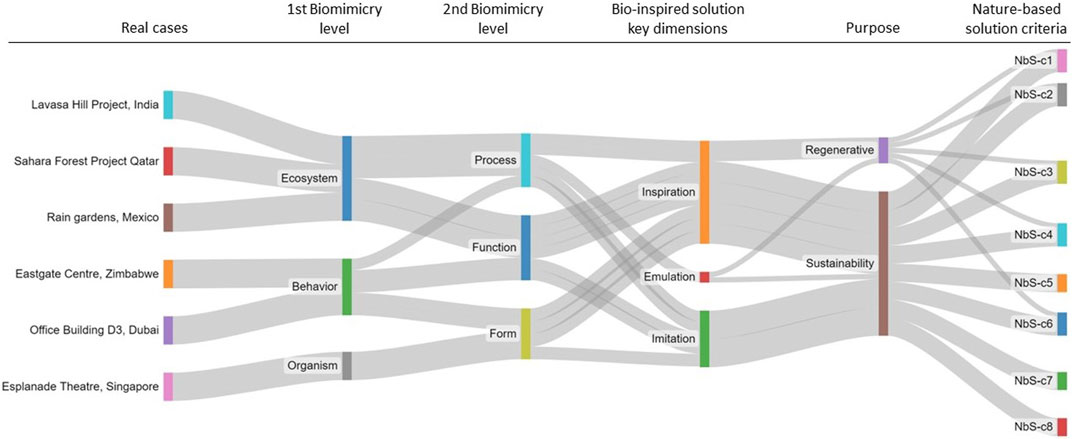
FIGURE 6. Sankey diagram to link the real case studies with the different biomimicry levels, biomimicry key domains, purpose, and NbS criteria.
It is worth noting that the ecosystem level, involving the imitation of processes and functions, was the most frequently applied approach, with the primary goal of achieving sustainability in most of the case studies. In contrast, strategies inspired by the organism level remained less commonly utilized. Likewise, the objective of implementing regenerative solutions in the built environment was found to be limited, with only one case study fitting within this category. This objective was more prominently observed in projects based on nature-based solutions.
Among the case studies with a regenerative purpose, they covered NbS criteria 1, 2, 3, 4, and 6, but only one case study with a sense of sustainability covered all NbS criteria.
The most addressed criteria are 1 and 2, which effectively address societal challenges, and the design of NbS should be informed by scale, respectively. These two criteria englobe somewhat all sustainability pillars but focus mainly on welfare and the environment.
The economic pillar, NbS criterion fourth, is far less addressed. Similarly, criterions 5, 7, and 8 impose challenges beyond the scope of most case studies found due to these NbS complexity, especially at the urban scale, as they require stakeholders’ involvement, measurement, and policies, respectively, to ensure the effect of the Nbs in the long term. In this regard, an organization such as the ISO, through its TC 26 (ISO/TC 266, 2023), is directing efforts to bring together stakeholders and policies, standardizing definitions, and methods.
Finally, the analysis of such real case studies presented here evidences the efforts still required to develop both NbS and NiS in such climates fully but also brings forth the complexity and workload demand that an eight-criterion-NbS embraces to achieve sustainability. Focusing on nature to get inspiration for solving human technical problems is insufficient as even more complex problems, such as sustainability, involve economics, politics, and subjectivity (e.g., human behavior and emotions). This may require a reinvention of the anthropogenic itself even to succeed in the NbS criteria fully. The aforementioned discussion highlights the novelty of this review.
7 Conclusion
The significant impact of human activities on the natural environment and the urgent need for sustainable development in urban areas to address the challenges posed by climate change highlights the importance of recognizing nature’s vital role in human existence.
Research on Nature-Based Solutions (NBS) in urban environments reveals the major challenges cities face, such as high energy consumption, greenhouse gas emissions, loss of green spaces, and stressful microclimatic conditions. These challenges are even more pronounced in humid and warm regions, where cities often lie in vulnerable areas susceptible to climate change-induced hazards. NBS should not be applied in the same way in all regions, rather they should be sensitive to both the socio-spatial context, climate specific, and the urban challenges of the place. Findings showed a substantial lack of implementation of bio-inspired solutions applied to humid and tropical climates, compared to continental and temperate climates. However, among such implementations found, biomimicry and biomimetics stand out as the most used approaches, which leads to sustainable development.
Bio-inspired design, including biomimicry, emerges as a promising approach to creating efficient and resilient cities while minimizing environmental impact, promoting resource efficiency, and contributing to a clean and circular economy. Bio-inspired concepts have gained traction in modern architectural design, drawing inspiration from nature’s forms, functions, materials, and sustainable principles. By looking to nature as a mentor and learning from its adaptability, the built environment can be developed more harmoniously and sustainably, reducing environmental degradation and resource exploitation.
Finally, a paradigm shift is needed toward ecological development and greater integration with natural ecosystems in urban planning and design. By embracing nature’s wisdom and applying bio-inspired concepts, urban areas can become more resilient, energy-efficient, and environmentally friendly, contributing to a sustainable and healthier future for humanity.
Author contributions
TS: Data curation, Formal Analysis, Investigation, Methodology, Writing–original draft. AB: Data curation, Visualization, Writing–original draft. DM: Funding acquisition, Project administration, Supervision, Writing–review and editing. MC: Funding acquisition, Project administration, Supervision, Writing–review and editing.
Funding
The author(s) declare financial support was received for the research, authorship, and/or publication of this article. This research was funded by Sistema Nacional de Investigación (SNI) and a Panamanian Institution Secretaría Nacional de Ciencia, Tecnología e Innovación (SENACYT) under the project code IDDS22- 30.
Acknowledgments
The authors would like to thank the Research Group Energy and Comfort in Bioclimatic Buildings (ECEB, https://eceb.utp.ac.pa/) Faculty of Mechanical Engineering within the Universidad Tecnológica de Panamá for their collaboration.
Conflict of interest
The authors declare that the research was conducted in the absence of any commercial or financial relationships that could be construed as a potential conflict of interest.
Publisher’s note
All claims expressed in this article are solely those of the authors and do not necessarily represent those of their affiliated organizations, or those of the publisher, the editors and the reviewers. Any product that may be evaluated in this article, or claim that may be made by its manufacturer, is not guaranteed or endorsed by the publisher.
References
Abdel-Rahman, W. S. M. (2021). Thermal performance optimization of parametric building envelope based on bio-mimetic inspiration. Ain Shams Eng. J. 12 (1), 1133–1142. Ain Shams University. doi:10.1016/j.asej.2020.07.007
Amat, R. C., Ismail, S., Wahab, M. H., Ahmad, N. H., and Rani, W. N. M. W. M. (2020). “A dimension of biophilia in urban design,” in IOP Conference Series: Earth and Environmental Science, Changchun, China, 21-23 August 2020. Bristol, England (IOP Publishing Ltd.). doi:10.1088/1755-1315/409/1/012016
Andreucci, M. B., Loder, A., Brown, M., and Brajković, J. (2021). Exploring challenges and opportunities of biophilic urban design: evidence from research and experimentation. Sustain. Switz. 13 (8), 4323. doi:10.3390/su13084323
Araque, K., Palacios, P., Mora, D., and Chen Austin, M. (2021). Biomimicry-based strategies for urban heat island mitigation: a numerical case study under tropical climate. Biomimetics (Basel) 6 (3), 48. doi:10.3390/biomimetics6030048
Austin, M. C., Araque, K., Palacios, P., Maure, K. R., and Mora, D. (2022). Numerical assessment of zebra-stripes-based strategies in buildings energy performance: a case study under tropical climate. Biomimetics 7 (1), 14. doi:10.3390/BIOMIMETICS7010014
Austin, M. C., Garzola, D., Delgado, N., Jiménez, J. U., and Mora, D. (2020). Inspection of biomimicry approaches as an alternative to address climate-related energy building challenges: a framework for application in Panama. Biomimetics 5 (3), 40. doi:10.3390/BIOMIMETICS5030040
Babí Almenar, J., Elliot, T., Rugani, B., Philippe, B., Navarrete Gutierrez, T., Sonnemann, G., et al. (2021). Nexus between nature-based solutions, ecosystem services and urban challenges. Land use policy 100, 104898. doi:10.1016/j.landusepol.2020.104898
Bader, F., Halabi Associate Professor, M., Mohsen Assistant Professor, H., and Youssef Associate Professor, M. (2021). USE OF BIOMIMICRY DESIGN APPROACH IN CONSTRUCTING SUSTAINABLE RESILIENT STRUCTURES (CASE STUDY: PORT OF BEIRUT). BAU Journal-Creative Sustain. Dev. 2 (2). doi:10.54729/2789-8334.1041
Bayhan, H. G., and Karaca, E. (2019). SWOT analysis of biomimicry for sustainable buildings – a literature review of the importance of kinetic architecture applications in sustainable construction projects. IOP Conf. Ser. Mater Sci. Eng. 471 (8), 082047. doi:10.1088/1757-899X/471/8/082047
Bianciardi, A., Becattini, N., and Cascini, G. (2023). How would nature design and implement nature-based solutions? Nature-Based Solutions 3, 100047. doi:10.1016/J.NBSJ.2022.100047
Blanco, E., Zari, M. P., Raskin, K., and Clergeau, P. (2021). Urban ecosystem-level biomimicry and regenerative design: linking ecosystem functioning and urban built environments. Sustain. Switz. 13 (1), 1–12. MDPI AG. doi:10.3390/su13010404
Boaretto, J., Fotouhi, M., Tende, E., Aver, G. F., Marcon, V. R. R., Cordeiro, G. L., et al. (2021). Biomimetics and composite materials toward efficient mobility: a review. J. Compos. Sci. 5 (1), 22. MDPI AG. doi:10.3390/jcs5010022
Calabrese, E. (2015). The practice of biophilic design pathways to wellbeing view project. Available at: https://www.researchgate.net/publication/321959928.
Chayaamor-Heil, N. (2023). From bioinspiration to biomimicry in architecture: opportunities and challenges. Encyclopedia 3 (1), 202–223. doi:10.3390/encyclopedia3010014
Chen Austin, M., and Beermann, K. (2023). Including nature-based success measurement criteria in the life cycle assessment. Life Cycle Assess. Work. Title]. doi:10.5772/INTECHOPEN.110401
Chen Austin, M., Solano, T., Tejedor-Flores, N., Quintero, V., Boya, C., and Mora, D. (2022). “Bio-inspired approaches for sustainable cities design in tropical climate,” in Bionics and sustainable design. Editor S. S. Palombini Felipe Luis and Muthu (Singapore: Springer Nature Singapore), 333–365. doi:10.1007/978-981-19-1812-4_11
Dicks, H. (2023). The biomimicry revolution. Columbia: Columbia University Press. doi:10.7312/DICK20880
Dixit, S., and Stefańska, A. (2023). Bio-logic, a review on the biomimetic application in architectural and structural design. Ain Shams Eng. J. 14 (1), 101822. Ain Shams University, Feb. 01. doi:10.1016/j.asej.2022.101822
Dodón, A., Quintero, V., and Chen Austin, M. (2022). Energy storage system based on biomimetic strategies: concept design and performance assessment in buildings. J. Phys. Conf. Ser. 2385 (1), 12027. doi:10.1088/1742-6596/2385/1/012027
Eid, Y., El Ahwal, M., Ebied, M., and Aly, R. (2021). The chameleon biomimetic concept in architectural design: a review. Port-Said Eng. Res. J. 0 (0), 0. doi:10.21608/pserj.2021.49883.1071
Faragalla, A. M. A., and Asadi, S. (2022). Biomimetic design for adaptive building façades: a paradigm shift towards environmentally conscious architecture. Energies 15 (15), 5390. MDPI, Aug. 01. doi:10.3390/en15155390
Ferwati, M. S., Alsuwaidi, M., Shafaghat, A., and Keyvanfar, A. (2019). Employing biomimicry in Urban metamorphosis seeking for sustainability: case studies. Archit. City Environ. 14 (40), 133–162. doi:10.5821/ace.14.40.6460
HayesHaye, S., Desha, C., and Gibbs, M. (2019). Findings of case-study analysis: system-level biomimicry in built-environment design. Biomimetics 4 (4), 73. doi:10.3390/BIOMIMETICS4040073
Hobbie, S. E., and Grimm, N. B. (2020). Nature-based approaches to managing climate change impacts in cities. Philosophical Trans. R. Soc. B Biol. Sci. 375 (1794), 20190124. Royal Society Publishing. doi:10.1098/rstb.2019.0124
Imani, N., and Vale, B. (2022). Developing a method to connect thermal physiology in animals and plants to the design of energy efficient buildings. Biomimetics 7 (2), 67. MDPI, Jun. 01. doi:10.3390/biomimetics7020067
Indira, M., et al. (2022). Instituto para el Medio Ambiente y Desarrollo Sustentable Colectivo Jardines de Lluvia (2022). Manual de diseño e implementación de jardines infiltrantes. Gobierno del estado de colima.
ISO 18458 (2015). ISO 18458:2015 - biomimetics — terminology, concepts and methodology. Available at: https://www.iso.org/standard/62500.html (Accessed November 07, 2023).
ISO/TC 266 (2023). ISO/TC 266 - biomimetics. Available: https://www.iso.org/committee/652577.html (Accessed October 24, 2023).
IUCN (2020a). Global Standard for Nature-based Solution. A user-friendly framework for the verification, design and scaling up of NbS. 1. Gland, Switzerland: IUCN. doi:10.2305/IUCN.CH.2020.08.en
IUCN (2020b). Guidance for using the IUCN global standard for nature-based solutions. 1. Gland, Switzerland: IUCN. IUCN, International Union for Conservation of Nature. doi:10.2305/IUCN.CH.2020.09.en
Jamei, E., and Vrcelj, Z. (2021). Biomimicry and the built environment, learning from nature’s solutions. Appl. Sci. Switz. 11 (16), 7514. MDPI AG, Aug. 02. doi:10.3390/app11167514
Kabisch, N., Frantzeskaki, N., and Hansen, R. (2022). Principles for urban nature-based solutions. Ambio 51 (6), 1388–1401. doi:10.1007/S13280-021-01685-W
Kay, R., Jakubiec, J. A., Katrycz, C., and Hatton, B. D. (2023). Multilayered optofluidics for sustainable buildings. Proc. Natl. Acad. Sci. U. S. A. 120 (6), e2210351120. doi:10.1073/pnas.2210351120
Landrum, N. E., and Mead, T. (2022). Sustainability in the biom* Singapore. Springer, 1–15. doi:10.1007/978-981-19-1812-4_1/COVER
Matthews, J., Ocampo, E., and Cruz, D. (2022). Integrating nature-based solutions for climate change adaptation and disaster risk management: a practitioner’s guide.
Mirniazmandan, S., and Rahimianzarif, E. (2017). Biomimicry an approach toward sustainability of high-rise buildings. J. Archit. Eng. Technol. 06 (02). doi:10.4172/2168-9717.1000203
Nkandu, M., and Research, H. A.-A., (2018). Biomimicry as an alternative approach to sustainability. Archit. Res. 8 (1), 1–11. doi:10.5923/j.arch.20180801.01
Oguntona, O. A., and Aigbavboa, C. O. (2023a). Nature inspiration, imitation, and emulation: biomimicry thinking path to sustainability in the construction industry. Front. Built Environ. 9, 1085979. doi:10.3389/fbuil.2023.1085979
Oguntona, O. A., and Aigbavboa, C. O. (2023b). Nature inspiration, imitation, and emulation: biomimicry thinking path to sustainability in the construction industry. Front. Built Environ. 9. doi:10.3389/fbuil.2023.1085979
Othmani, N. I., Mohamed, S. A., Abdul Hamid, N. H., Ramlee, N., Yeo, L. B., and Mohd Yunos, M. Y. (2022). Reviewing biomimicry design case studies as a solution to sustainable design. Environ. Sci. Pollut. Res. 29 (46), 69327–69340. Springer Science and Business Media Deutschland GmbH. doi:10.1007/s11356-022-22342-z
Pearlmutter, D., Theochari, D., Nehls, T., Pinho, P., Piro, P., Korolova, A., et al. (2020). Enhancing the circular economy with nature-based solutions in the built urban environment: green building materials, systems and sites. Blue-Green Syst. 2 (1), 46–72. doi:10.2166/bgs.2019.928
Pineda-Pinto, M., Frantzeskaki, N., and Nygaard, C. A. (2021). The potential of nature-based solutions to deliver ecologically just cities: lessons for research and urban planning from a systematic literature review. Ambio 51 (1), 167–182. doi:10.1007/S13280-021-01553-7
Quintero, A., Zarzavilla, M., Tejedor-Flores, N., Mora, D., and Austin, M. C. (2021). Sustainability assessment of the anthropogenic system in Panama city: application of biomimetic strategies towards regenerative cities. Biomimetics 6 (4), 64. doi:10.3390/BIOMIMETICS6040064
Sanga, R., Kilumile, M., and Mohamed, F. (2022). Alternative clay bricks inspired from termite mound biomimicry. Case Stud. Constr. Mater. 16, e00977. doi:10.1016/J.CSCM.2022.E00977
Shah, K. W., and Huseien, G. F. (2020). Biomimetic self-healing cementitious construction materials for smart buildings. Biomimetics 5 (4), 47–22. MDPI AG. doi:10.3390/biomimetics5040047
Shashwat, S., Zingre, K. T., Thurairajah, N., Kumar, D. K., Panicker, K., Anand, P., et al. (2023). A review on bioinspired strategies for an energy-efficient built environment. Energy Build. 296, 113382. doi:10.1016/J.ENBUILD.2023.113382
Sowińska-Świerkosz, B., and García, J. (2022). What are Nature-based solutions (NBS)? Setting core ideas for concept clarification. Nature-Based Solutions 2, 100009. doi:10.1016/j.nbsj.2022.100009
Speck, O., and Speck, T. (2019). An overview of bioinspired and biomimetic self-repairing materials. Biomimetics 4 (1), 26. doi:10.3390/BIOMIMETICS4010026
Srinivsan, P. (2020). Corporate sustainability reporting and firm performance linkage-A literature review approach biomimicry in architecture-A mindful imitation of nature. PJAEE 17 (9) https://archives.palarch.nl/index.php/jae/article/view/5532 (Accessed on: November 20, 2023).
Stevens, L., Kopnina, H., Mulder, K., and De Vries, M. (2021). Biomimicry design thinking education: a base-line exercise in preconceptions of biological analogies. Int. J. Technol. Des. Educ. 31 (4), 797–814. doi:10.1007/s10798-020-09574-1
Tiwari, A., Terada, D., and Kobayash, H. (2011). Polyvinyl modified guar-gum bioplastics for packaging applications. Handb. Bioplastics Biocomposites Eng. Appl., 177–188. doi:10.1002/9781118203699.ch7
Uchiyama, Y., Blanco, E., and Kohsaka, R. (2020). Application of biomimetics to architectural and urban design: a review across scales. Sustain. Switz. 12 (23), 9813–9815. MDPI. doi:10.3390/su12239813
Urdinola-Serna, D., and diseño, B. y (2018). Primera Edición, 2018. Proyecto: repertorio de superficies y texturas bioinspiradas a través de experimentaciones morfológicas con tecnología de fabricación digital. Radicado 601B-05/16-35. Available at: https://www.upb.edu.co.
Wu, Y., Swain, R. E., Jiang, N., Qiao, M., Wang, H., Bai, J., et al. (2020). Design with nature and eco-city design. Ecosyst. Health Sustain. 6 (1). Taylor and Francis Ltd., Dec. 16, 2020. doi:10.1080/20964129.2020.1781549
Keywords: bio-inspired, biomimetics, biomimicry, built environment, humid climates, nature-based inspiration, tropical climates
Citation: Solano T, Bernal A, Mora D and Chen Austin M (2023) How bio-inspired solutions have influenced the built environment design in hot and humid climates. Front. Built Environ. 9:1267757. doi: 10.3389/fbuil.2023.1267757
Received: 27 July 2023; Accepted: 14 November 2023;
Published: 28 November 2023.
Edited by:
Hasim Altan, Prince Mohammad bin Fahd University, Saudi ArabiaReviewed by:
Naglaa Ali Megahed, Port Said University, EgyptBen Croxford, University College London, United Kingdom
Copyright © 2023 Solano, Bernal, Mora and Chen Austin. This is an open-access article distributed under the terms of the Creative Commons Attribution License (CC BY). The use, distribution or reproduction in other forums is permitted, provided the original author(s) and the copyright owner(s) are credited and that the original publication in this journal is cited, in accordance with accepted academic practice. No use, distribution or reproduction is permitted which does not comply with these terms.
*Correspondence: Miguel Chen Austin, bWlndWVsLmNoZW5AdXRwLmFjLnBh
 Thasnee Solano1
Thasnee Solano1 Dafni Mora
Dafni Mora Miguel Chen Austin
Miguel Chen Austin